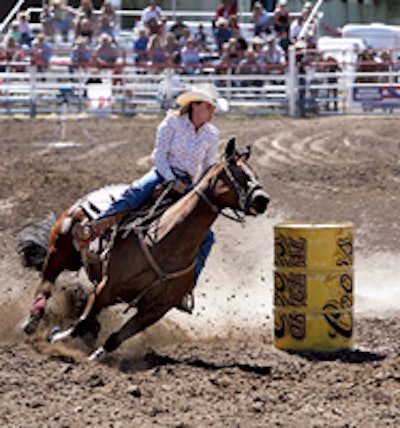
The Prescott Frontier Days in Prescott, Arizona
Photo: Franz Rosenberger
The people who coordinate rodeos have to be quick on the draw, since their signature activity takes place in eight-second increments. Here’s how they manage the wild rides of their jobs among bulls, broncos, and oversize belt buckles.
Keep on top of paperwork. “Initially, we were doing our pyro contracts just a few shows at a time, and one time I let the contract run out and forgot about it,” says Clayton Cullen, senior vice president of production for Pueblo, Colorado-based Professional Bull Riders Inc. “I got a couple weeks out from an event, realized I had no pyro contract, and just about had a coronary. The pyrotechnics are our signature and a major part of our show. I really had to scramble to get the permits and products, and we barely pulled it off. Failure is the best teacher: It makes a mark in your mind, and I never forgot that again.”Have backup vendors. “Last year, we’d made arrangements for a farrier [an equine foot-care specialist] to be on call, but apparently he was also booked for a barrel-racing convention the same day,” says Dusty West, former rodeo director for the Diamond State Rodeo Association in Little Rock, Arkansas. “When one of the contestants needed a special horseshoe, he wouldn’t leave and come help us. We did eventually find another one to come out, but because it was last minute, it cost us $500. We’ve learned it’s better to have a couple of backups.”
Prepare for uncooperative weather. “The weather is our biggest challenge,” says Marvin Witt, vice president of operations for the National Western Rodeo in Denver. “In 2007, the final Sunday was January 23, and we had a snowstorm. Our rodeo livestock are kept 45 miles from town at a ranch, so to get the horses and bulls to Denver we had to have two snowplows lead the way for our trailers to get to the interstate.”
Find the right people for jobs. “I’ve learned you’re only as good as the people around you,” says John Reyes, president of Prescott Frontier Days in Prescott, Arizona. “My board is voted in, so I have no choice over who comes and who goes. What I do is talk to each of them and put them in an area where I feel they’ll be best suited. My success comes from knowing I’m a people person and that I can put people where I need them.”
Use multiple communication methods. "I work with a lot of our volunteers, and they range from stay-at-home moms to astronauts, so they all bring different skills to the table and need to be communicated with in different ways,” says Mary Catherine Schultz, managing director of Rodeo Houston. “You need to work with their availability and have a very detailed time line and chain of communication. We do a lot of both snail mail and email, and post all of our communications on our Web site as well.”
Watch for unexpected opportunities. “Dan Aykroyd was in the audience at Madison Square Garden in New York City,” says the PBR’s Cullen. “We spotted him up there, and I pointed him out to my music guy. During one of the lulls in the action, he started playing ‘Soul Man,’ and Dan went right into his Blues Brothers dance routine, which we picked up with our cameras and put on the big screen. He was rocking out right in character, and the audience just went nuts. You can’t plan for moments like that, but they’ll present themselves if you’re observant.”
Put yourself in your guests’ shoes. “I can remember going to rodeos as a kid back in the ’50s,” says National Western’s Witt. “As a child growing up on a farm in North Dakota, that was the one thing we did as a family for entertainment. As a spectator, I learned how I want to be entertained. I always put myself in the seats. Today, people won’t sit for four hours and watch a rodeo the way they did when I was growing up. Now their attention span is two hours and 10 minutes.”
Expand beyond your traditional audience. “We’re doing advertising and marketing not only in our community but throughout the U.S. and Europe,” says Prescott Frontier Days’ Reyes. “We’re promoting our rodeo through PR and marketing in the U.K. Last year, we had people come from as far as Ireland. Out of 50,000 total audience members, we might get 100 people from the U.K., but that’s pretty good when you think about how far they’re coming—and that number is going up.”
Secure all moving parts. “One time, somebody opened up the big roll-up door to the arena, and our $30,000 radio-controlled blimp got caught in an updraft and went right up to the rafters,” says the PBR’s Cullen. “It’s lightweight but huge. I didn’t think we were ever going to get it down, or [thought] it was going to snag on something and tear.”
Keep on top of paperwork. “Initially, we were doing our pyro contracts just a few shows at a time, and one time I let the contract run out and forgot about it,” says Clayton Cullen, senior vice president of production for Pueblo, Colorado-based Professional Bull Riders Inc. “I got a couple weeks out from an event, realized I had no pyro contract, and just about had a coronary. The pyrotechnics are our signature and a major part of our show. I really had to scramble to get the permits and products, and we barely pulled it off. Failure is the best teacher: It makes a mark in your mind, and I never forgot that again.”Have backup vendors. “Last year, we’d made arrangements for a farrier [an equine foot-care specialist] to be on call, but apparently he was also booked for a barrel-racing convention the same day,” says Dusty West, former rodeo director for the Diamond State Rodeo Association in Little Rock, Arkansas. “When one of the contestants needed a special horseshoe, he wouldn’t leave and come help us. We did eventually find another one to come out, but because it was last minute, it cost us $500. We’ve learned it’s better to have a couple of backups.”
Prepare for uncooperative weather. “The weather is our biggest challenge,” says Marvin Witt, vice president of operations for the National Western Rodeo in Denver. “In 2007, the final Sunday was January 23, and we had a snowstorm. Our rodeo livestock are kept 45 miles from town at a ranch, so to get the horses and bulls to Denver we had to have two snowplows lead the way for our trailers to get to the interstate.”
Find the right people for jobs. “I’ve learned you’re only as good as the people around you,” says John Reyes, president of Prescott Frontier Days in Prescott, Arizona. “My board is voted in, so I have no choice over who comes and who goes. What I do is talk to each of them and put them in an area where I feel they’ll be best suited. My success comes from knowing I’m a people person and that I can put people where I need them.”
Use multiple communication methods. "I work with a lot of our volunteers, and they range from stay-at-home moms to astronauts, so they all bring different skills to the table and need to be communicated with in different ways,” says Mary Catherine Schultz, managing director of Rodeo Houston. “You need to work with their availability and have a very detailed time line and chain of communication. We do a lot of both snail mail and email, and post all of our communications on our Web site as well.”
Watch for unexpected opportunities. “Dan Aykroyd was in the audience at Madison Square Garden in New York City,” says the PBR’s Cullen. “We spotted him up there, and I pointed him out to my music guy. During one of the lulls in the action, he started playing ‘Soul Man,’ and Dan went right into his Blues Brothers dance routine, which we picked up with our cameras and put on the big screen. He was rocking out right in character, and the audience just went nuts. You can’t plan for moments like that, but they’ll present themselves if you’re observant.”
Put yourself in your guests’ shoes. “I can remember going to rodeos as a kid back in the ’50s,” says National Western’s Witt. “As a child growing up on a farm in North Dakota, that was the one thing we did as a family for entertainment. As a spectator, I learned how I want to be entertained. I always put myself in the seats. Today, people won’t sit for four hours and watch a rodeo the way they did when I was growing up. Now their attention span is two hours and 10 minutes.”
Expand beyond your traditional audience. “We’re doing advertising and marketing not only in our community but throughout the U.S. and Europe,” says Prescott Frontier Days’ Reyes. “We’re promoting our rodeo through PR and marketing in the U.K. Last year, we had people come from as far as Ireland. Out of 50,000 total audience members, we might get 100 people from the U.K., but that’s pretty good when you think about how far they’re coming—and that number is going up.”
Secure all moving parts. “One time, somebody opened up the big roll-up door to the arena, and our $30,000 radio-controlled blimp got caught in an updraft and went right up to the rafters,” says the PBR’s Cullen. “It’s lightweight but huge. I didn’t think we were ever going to get it down, or [thought] it was going to snag on something and tear.”



















